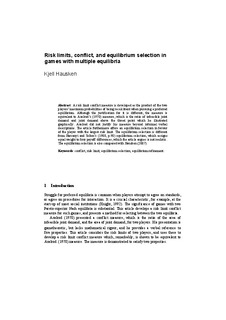| dc.contributor.author | Hausken, Kjell | |
| dc.date.accessioned | 2013-08-24T10:40:05Z | |
| dc.date.available | 2013-08-24T10:40:05Z | |
| dc.date.issued | 2009 | |
| dc.identifier.citation | Hausken, K. (2009) Risk limits, conflict, and equilibrium selection in games with multiple equilibria. International Journal of Decision Sciences, Risk and Management, 1(1-2), pp. 54-65 | no_NO |
| dc.identifier.uri | http://hdl.handle.net/11250/184305 | |
| dc.description | The article was originally published as follows: Hausken, K. (2009) ‘Risk
limits, conflict, and equilibrium selection in games with multiple equilibria’,
Int. J. Decision Sciences, Risk and Management, Vol. 1, Nos. 1/2, pp.54–65. Posted here with permission from Inderscience. | no_NO |
| dc.description.abstract | A risk limit conflict measure is developed as the product of the two
players’ maximum probabilities of being recalcitrant when pursuing a preferred
equilibrium. Although the justification for it is different, the measure is
equivalent to Axelrod’s (1970) measure, which is the ratio of infeasible joint
demand and joint demand above the threat point which he illustrated
graphically. Axelrod did not justify his measure beyond informal verbal
descriptions. The article furthermore offers an equilibrium selection in favour
of the player with the largest risk limit. The equilibrium selection is different
from Harsanyi and Selten’s (1988, p.90) equilibrium selection, which assigns
equal weight to four payoff differences, which the article argues is not realistic.
The equilibrium selection is also compared with Hausken (2007). | no_NO |
| dc.language.iso | eng | no_NO |
| dc.publisher | Inderscience | no_NO |
| dc.subject | game theory | no_NO |
| dc.subject | conflict | no_NO |
| dc.subject | risk limit | no_NO |
| dc.subject | equilibrium | no_NO |
| dc.title | Risk limits, conflict, and equilibrium selection in games with multiple equilibria | no_NO |
| dc.type | Journal article | no_NO |
| dc.type | Peer reviewed | no_NO |
| dc.subject.nsi | VDP::Social science: 200 | no_NO |
| dc.source.pagenumber | 54-65 | no_NO |
| dc.source.volume | 1 | no_NO |
| dc.source.journal | International Journal of Decision Sciences, Risk and Management | no_NO |
| dc.source.issue | 1-2 | no_NO |
| dc.identifier.doi | 10.1504/IJDSRM.2009.027246 | |
